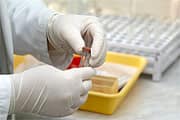Life Extension Magazine®
When it comes to lethal FDA-approved drugs, I always felt that Life Extension® members had a better chance of surviving adverse reactions compared to the general public. One reason is that members have their blood tested annually so they can detect many types of drug toxicities before permanent damage is inflicted. Another defense members have are the healthy lifestyles they follow, which confers protection against mechanisms by which prescription drugs kill, such as glutathione depletion and fatty acid metabolite imbalance.1-5 As it relates to the fraudulent drug you are going to read about, however, it would have been challenging for any of us to survive. This deadly drug was administered intravenously during complex surgical procedures where one’s life is completely at the mercy of others. I am going to relate what may be the most atrocious cover-up of a toxic drug that a pharmaceutical company has ever perpetrated—a drug that the FDA should have never approved. Why Some Surgery Patients Need These Kinds of DrugsA common surgical complication is excessive bleeding. In patients at high risk of bleeding, intravenous drugs are administered ahead of time. While lower-cost alternative drugs are available to reduce bleeding complications, pharmaceutical giant Bayer successfully penetrated the market with a drug called Trasylol® that costs about $1,000 per patient. If you wonder how this kind of price gouging occurs, large drug companies aggressively promote expensive new drugs to doctors, in some cases paying cash kickbacks so that the more expensive drug is used in place of an alternative of equal efficacy. In the case of Trasylol®, the results turned tragic. The FDA’s Erroneous Approval of Trasylol®Despite data showing that Trasylol® inflicted severe kidney damage in animals,6 the FDA approved it for human use in 1993.7 Low-cost alternative anti-bleeding drugs are less likely to produce this lethal side effect.
Soon, the same kidney side effects observed in animals were occurring in humans. One surgeon observed that the most common side effect seen in patients given Trasylol® was renal dysfunction. This surgeon then conducted a 20-patient study (not funded by Bayer) and found that 13 of 20 patients given Trasylol® had problems with kidney function after the surgical procedure.8 When the FDA approved Trasylol®, they did note that kidney toxicity was a problem. But Bayer lobbied the FDA hard, and by 1998, the FDA expanded approval of Trasylol® to cover all heart bypass patients.9 Sales of Trasylol® in 2005 hit $300 million, and Bayer envisioned a billion-dollar-per-year blockbuster.10 These kinds of profits provide an enormous war chest to lobby FDA officials to turn a blind eye, even while thousands of surgical patients were dying each year from kidney failure caused by Trasylol®. Investigators were initially perplexed because kidney toxicity showed up in some studies, but not others. Critics maintain that Bayer never paid for studies large enough to determine the renal toxicity of Trasylol®. The primary side effect mechanism of Trasylol® is that it causes excess blood clotting inside blood vessels (thrombosis).11 This made tissues throughout the body vulnerable to loss of blood flow, which is why patients given Trasylol® sometimes died from multiple organ failure—plus amputation of limbs. Trasylol® Carnage Covered Up by Bayer
In 2006, a study was released showing that thousands of Americans were being killed each year by Trasylol®.11 The FDA responded by issuing an “advisory” alerting doctors to this potential problem, but did not plan to have a formal meeting about Trasylol® for eight months.12,13 Bayer was desperate to keep Trasylol® on the market, so they hired a respected Harvard professor to look at the records of nearly 70,000 patients treated with Trasylol®. The Harvard professor’s report did not please Bayer. It revealed that horrific numbers of Americans had died from Trasylol®. The Harvard professor wrote that patients on Trasylol® had an elevated risk of death and acute kidney failure.10 When the FDA finally held an advisory committee meeting to address the Trasylol® deaths, Bayer intentionally withheld the Harvard professor’s exhaustive study.14 Since the FDA did not know of Bayer’s negative study, it voted to keep Trasylol® on the market. A week later, the Harvard professor went to the FDA to inform them that Bayer had hidden the study showing the lethal dangers of Trasylol®.15 The FDA’s response was to issue another warning to doctors.16 Bayer meanwhile continued to sell hundreds of millions of dollars worth of Trasylol® to unsuspecting surgical patients. One Thousand Lives Lost Each Month Because of the FDA’s Delay in Removing Trasylol®In 2007, the Canadian government terminated a study using Trasylol® because too many patients were dying.17 Germany responded to this study by banning Trasylol® altogether.18 The FDA’s initial response was to convince Bayer to suspend marketing of Trasylol® only temporarily.19,20 In 2008, amid a flurry of lawsuits, Bayer announced that it was removing the remaining supply of Trasylol® from the American market.21 Experts estimate that had the FDA taken action when the first report came out, 22,000 lives could have been saved—which equates to about 1,000 needless deaths each month the FDA failed to act.10 Bayer suspended two employees22 for failing to disclose the Harvard study to the FDA. As with other pharmaceutical companies that cover up the lethal dangers of their drugs, the FDA has taken no action against Bayer. Contrast FDA inaction against Bayer to FDA’s threats to imprison growers of cherries and walnuts for promoting the health benefits of their foods. 23,24 |
Why Health Care Costs So MuchThe side effects attributed to Trasylol® include heart attack, stroke, kidney failure, and excruciating slow deaths.25 The medical costs of caring for patients injured by Trasylol® are incomprehensible. In some cases, relatively healthy people suffered so much tissue damage that they were hospitalized in ICU units for months before they died. Other victims require thrice weekly kidney dialysis, kidney transplants, lifetime nursing home care, and numerous other medical costs, not to mention lost productivity.26,27 If you ever wonder why medical costs are bankrupting the United States, look no further than the fraudulently approved drugs that permeate the marketplace. When government-approved medicines inflict this kind of carnage, the inevitable result is an explosive growth in the numbers of Americans requiring expensive chronic healthcare. Federal Government Does Not Protect UsIn this issue of Life Extension Magazine®, we reprint an article published by CNN titled “Feds Found Pfizer Too Big to Nail.” It describes in detail the criminal activities Pfizer perpetrated to illegally market the drug Bextra® to treat surgical pain. Like other drugs in the COX-2 inhibitor class, Bextra® was shown to increase heart attack risk and was withdrawn from the market.28 The unfortunate consequence for many surgical patients, however, is that they were exposed to two lethal drugs (Trasylol® and Bextra®) at a time when these patients were particularly vulnerable to pathological clotting inside blood vessels (thrombosis).
Trasylol® was first administered intravenously to prevent excess bleeding, but in reality it caused excess blood clotting inside the arteries of many of its victims.29 In the post-surgical setting, patients were sometimes prescribed a double dose of Bextra® to alleviate surgical pain. One pathological effect of Bextra® is to increase a fatty acid metabolite called thromboxane A2, which further increases thrombotic risk.4,5 If you wonder why so many hospital patients die from “surgical complications,” look no further than FDA-approved drugs they were given. Trasylol® was allowed to remain on the market for 14 years, whereas Bextra® was illegally touted for less than 5 years before being withdrawn.30 Life Extension warned about the dangers of drugs like Bextra® and Vioxx® within a year of the FDA approving them.31 We were in the dark about Trasylol®, however, since this was a drug that surgeons made a decision on using. The bottom line is that prescription drug costs are contributing to the bankruptcy of this nation’s healthcare system. Yet the federal government continues to deceive consumers into believing that they must pay inflated costs in order to be assured of safety and efficacy. The reality is that high costs give pharmaceutical companies enormous profits that they use to fraudulently promote their drugs, pay off doctors, and lobby the FDA/Congress to protect their stranglehold over what drugs consumers have access to.32-34 Life Extension remains committed to protecting its members against the blatant corruption that exists today between pharmaceutical companies that engage in fraud to promote dangerous drugs and the politicians and bureaucrats who allow this murderous conspiracy to perpetuate. Blood Tests Can Detect Drug Toxicities in Time to Reverse DamageBlood tests that evaluate liver, kidney, muscle, and bone marrow function can detect a wide range of drug toxicities long before permanent damage occurs. For instance, if a blood test finding uncovers specific tissue damage, a careful evaluation of the drugs you are taking can pinpoint the one causing the problem so you can discontinue it. This usually reverses the damage. Failure to catch a drug-induced pathology in time can result in irreversible system failure. Regular blood testing can also enable your doctor to adjust the dose of drugs you are taking, and enable you to change your nutrient dose in order to obtain better and safer results. For example, doctors often prescribe the same dose of a statin drug to every patient. The problem is that the dose of statin drugs required varies considerably between patients. Some can take a small dose (10 mg/day) of a drug like simvastatin and achieve LDL levels below 80 mg/dL, whereas others require higher doses (in addition to nutritional interventions). Comprehensive blood tests function as a “report card” to verify that medications, hormones, and supplements you take each day are providing the desired benefits and not inflicting side effects.
When it comes to over-the-counter (OTC) drug toxicity, we at Life Extension have uncovered it in people as young as 21 years old and reversed it by getting them off high-dose analgesics like ibuprofen. Annual blood testing saves lives not only by detecting drug toxicities, but also revealing vascular risk factors such as elevated triglycerides, glucose, C-reactive protein, and LDL in time to take corrective actions. Hormone imbalances can also be uncovered by proper blood testing. Results from these tests provide a roadmap to enable hormones to be safely restored to youthful ranges. Low-Cost, Convenient Blood TestingThe high prices charged by commercial labs deny most people access to comprehensive blood tests. This is a tragedy as proper blood testing can identify reversible factors before stroke, cancer, kidney failure, diabetes, or coronary artery blockage is diagnosed. Life Extension has torn down these high-cost barriers by offering comprehensive Male and Female Blood Test Panels. Once a year, we discount these popular panels down to only $199—which is about 80% less than what commercial labs charge. When you place your order, we send you a pre-filled-in requisition form and list of drawing stations in your area where you can go at your convenience. The Blood Test Super Sale this year expires on June 6, 2011. You should not delay in placing your order to take advantage of these extra-discounted prices. Once you have your requisition form, you can have your blood drawn anytime thereafter. The results are mailed directly to you. If you have any questions when your results come back, you are welcome to call our health advisor helpline. The chart below describes the many tests included in the comprehensive Male and Female Blood Test Panels and the ease with which you can order them today. For longer life,
William Faloon
P.S. If you want to view the televised report that CBS News did on the Trasylol® travesty, just go to Google and type in: “Trasylol® and 60 Minutes. | |||||||||||||||||||
| References | |||||||||||||||||||
| 1. Available at: http://www.mefmaction.net/MECFSFM/Articles /Treatment/GlutathioneDeficiency/tabid/236/Default.aspx. Accessed November 25, 2010 2. Available at: http://www.chiro.org/nutrition/FULL/Recognizing_Drug_Induced_Nutrient_Depletion.shtml. Accessed November 25, 2010. 3. Jaeschke H, Bajt ML. Intracellular signaling mechanisms of acetaminophen-induced liver cell death. Toxicol Sci. 2006 Jan;89(1):31-41. 4. Fitzgerald GA. Coxibs and cardiovascular disease. N Engl J Med. 2004 Oct 21;351(17):1709-11. 5. Oates JA, FitzGerald GA, Branch RA, Jackson EK, Knapp HR, Roberts LJ 2nd. Clinical implications of prostaglandin and thromboxane A2 formation (1). N Engl J Med. 1988 Sep 15;319(11):689-98. 6. Fischer JH, Knupfer P. High-dosage aprotinin (Trasylol) therapy--is it safe for the kidney? Langenbecks Arch Chir. 1983;360(4):241-9. 7. Available at: http://www.fda.gov/Drugs/DrugSafety/ PostmarketDrugSafetyInformationforPatientsandProviders/ucm142740.htm. Accessed March 15, 2011. 8. Sundt TM 3rd, Kouchoukos NT, Saffitz JE, Murphy SF, Wareing TH, Stahl DJ. Renal dysfunction and intravascular coagulation with aprotinin and hypothermic circulatory arrest. Ann Thorac Surg. 1993 Jun;55(6):1418-24. 9. Mangano DT, Miao Y, Vuylsteke A, et al. Mortality associated with aprotinin during 5 years following coronary artery bypass graft surgery. JAMA. 2007 Feb 7;297(5):471-9. 10. Available at: http://www.cbsnews.com/stories/2008/02/14/60minutes/main3831900.shtml. Accessed December 6, 2010. 11. Mangano DT, Tudor IC, Dietzel C; Multicenter Study of Perioperative Ischemia Research Group; Ischemia Research and Education Foundation. The risk associated with aprotinin in cardiac surgery. N Engl J Med. 2006 Jan 26;354(4):353-65. 12. Available at: http://www.fda.gov/NewsEvents/Newsroom/PressAnnouncements/2006/ucm108592.htm. Accessed November 30, 2010. 13. Available at: http://www.investor.bayer.de/en/news/archive/investor-news-2006/ investor news/showNewsItem/669/1170082441/9c4ca18b75/. Accessed November 30, 2010. 14. Available at: http://www.investor.bayer.de/en/news/archive/investor-news-2006/ investor-news/showNewsItem/673/1168957317/5620356922/. Accessed November 30, 2010. 15. Available at: http://www.corpwatch.org/article.php?id=14185. Accessed December 2, 2010. 16. Available at: http://www.fda.gov/Drugs/DrugSafety/ PostmarketDrugSafetyInformationforPatientsandProviders/ucm142736.htm. Accessed December 2, 2010. 17. Available at: http://www.washingtonpost.com/wp-dyn/content/article/2008/05/14/AR2008051401658.html. Accessed December 2, 2010. 18. Available at: http://www.bayer.ca/files/Trasylol,%20BART,%20November%205,%20FINAL,%20Release.pdf. Accessed December 2, 2010. 19. Available at: http://www.investor.bayer.de/en/news/archive/investor-news-2007 /investor-news/showNewsItem/868/1201512120/450afb010b. Accessed December 2, 2010. 20. Available at: http://www.fda.gov/downloads/NewsEvents/Newsroom/MediaTranscripts/UCM122284.pdf. Accessed December 2, 2010. 21. Available at: http://www.consumeraffairs.com/news04/2008/05/fda_trayslol.html. Accessed December 6, 2010. 22. Available at: http://articles.latimes.com/2006/oct/14/business/fi-bayer14. Accessed March 15, 2011. 23. Faloon W. FDA threatens to raid cherry orchards. Life Extension Magazine®. 2006 Mar;12(3): 7-11. 24. Faloon W. FDA says walnuts are illegal drugs. Life Extension Magazine®. Publication pending. 25. Available at: http://www.drugwatch.com/trasylol/side-effects.php. Accessed December 6, 2010. 26. Available at: http://www.fda-reports.com/Trasylol.html. Accessed December 9, 2010. 27. Available at: http://www.adrugrecall.com/trasylol/kidney-failure.html. Accessed December 10, 2010. 28. Available at: http://doublecheckmd.com/EffectsDetail.do?dname=Trasylol&sid=1439&eid=3076. Accessed December 10, 2010. 29. Available at: http://www.kcrlegal.com/trasylol.aspx. Accessed December 13, 2010. 30. Available at: http://arthritis.webmd.com/news/20050407/bextra-taken-off-market-celebrex-gets-warning. Accessed December 15, 2010. 31. Medications side effects. Life Extension Magazine®. 2003 Mar. 32. Available at: http://www.naturalnews.com/030111_drug_companies_illegal.html. Accessed December 17, 2010 33. Loewenberg S. US FDA feels the heat from Congressional hearings. Lancet. 2008 May 10;371(9624):1565-6. 34. Available at: http://projects.publicintegrity.org/rx/report.aspx?aid=723. Accessed December 17, 2010. | |||||||||||||||||||







